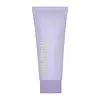What's inside
What's inside
 Key Ingredients
Key Ingredients

 Benefits
Benefits

 Concerns
Concerns

 Ingredients Side-by-side
Ingredients Side-by-side

Water
Skin ConditioningGlycerin
HumectantPotassium Cocoyl Glycinate
Disodium Laureth Sulfosuccinate
CleansingLauryl Hydroxysultaine
CleansingPotassium Cocoate
EmulsifyingAcrylates/C10-30 Alkyl Acrylate Crosspolymer
Emulsion Stabilising1,2-Hexanediol
Skin ConditioningTromethamine
BufferingDipropylene Glycol
HumectantSodium Chloride
MaskingLimonene
PerfumingHydroxyacetophenone
AntioxidantCaprylyl Glycol
EmollientLactobacillus/Rye Flour Ferment
Skin ConditioningLactobacillus/Soymilk Ferment Filtrate
Skin ConditioningBacillus/Soybean Ferment Extract
Skin ConditioningPropanediol
SolventCitrus Nobilis Peel Oil
MaskingDisodium EDTA
Citrus Aurantium Dulcis Peel Oil
MaskingCitrus Aurantium Bergamia Fruit Oil
MaskingSodium Hyaluronate
HumectantDipotassium Glycyrrhizate
HumectantRaspberry Ketone
MaskingEthylhexylglycerin
Skin ConditioningMentha Arvensis Leaf Oil
MaskingNiacinamide
SmoothingFolic Acid
Skin ConditioningPantothenic Acid
Skin ConditioningPyridoxine
Skin ConditioningThiamine Hcl
MaskingCyanocobalamin
Skin ConditioningRiboflavin
Cosmetic ColorantWater, Glycerin, Potassium Cocoyl Glycinate, Disodium Laureth Sulfosuccinate, Lauryl Hydroxysultaine, Potassium Cocoate, Acrylates/C10-30 Alkyl Acrylate Crosspolymer, 1,2-Hexanediol, Tromethamine, Dipropylene Glycol, Sodium Chloride, Limonene, Hydroxyacetophenone, Caprylyl Glycol, Lactobacillus/Rye Flour Ferment, Lactobacillus/Soymilk Ferment Filtrate, Bacillus/Soybean Ferment Extract, Propanediol, Citrus Nobilis Peel Oil, Disodium EDTA, Citrus Aurantium Dulcis Peel Oil, Citrus Aurantium Bergamia Fruit Oil, Sodium Hyaluronate, Dipotassium Glycyrrhizate, Raspberry Ketone, Ethylhexylglycerin, Mentha Arvensis Leaf Oil, Niacinamide, Folic Acid, Pantothenic Acid, Pyridoxine, Thiamine Hcl, Cyanocobalamin, Riboflavin
Water
Skin ConditioningPEG-8
HumectantMyristic Acid
CleansingGlycerin
HumectantStearic Acid
CleansingPotassium Hydroxide
BufferingSodium Methyl Cocoyl Taurate
CleansingPalmitic Acid
EmollientLauric Acid
CleansingPEG-32
HumectantGlyceryl Stearate
EmollientPEG-100 Stearate
Sorbitan Olivate
EmulsifyingLimonene
PerfumingArachidic Acid
CleansingMelaleuca Alternifolia Leaf Oil
AntioxidantDisodium EDTA
Melia Azadirachta Leaf Extract
Skin ConditioningPolyquaternium-7
Oleic Acid
EmollientCentella Asiatica Extract
CleansingMelia Azadirachta Flower Extract
Skin ConditioningCitrus Paradisi Peel Oil
Masking1,2-Hexanediol
Skin ConditioningHouttuynia Cordata Extract
Skin ConditioningMelaleuca Alternifolia Leaf Extract
PerfumingSalvia Officinalis Leaf Extract
CleansingCitrus Aurantium Bergamia Fruit Oil
MaskingSodium Benzoate
MaskingRosmarinus Officinalis Leaf Oil
MaskingLinalool
PerfumingC12-13 Pareth-9
EmulsifyingPiroctone Olamine
PreservativeWater, PEG-8, Myristic Acid, Glycerin, Stearic Acid, Potassium Hydroxide, Sodium Methyl Cocoyl Taurate, Palmitic Acid, Lauric Acid, PEG-32, Glyceryl Stearate, PEG-100 Stearate, Sorbitan Olivate, Limonene, Arachidic Acid, Melaleuca Alternifolia Leaf Oil, Disodium EDTA, Melia Azadirachta Leaf Extract, Polyquaternium-7, Oleic Acid, Centella Asiatica Extract, Melia Azadirachta Flower Extract, Citrus Paradisi Peel Oil, 1,2-Hexanediol, Houttuynia Cordata Extract, Melaleuca Alternifolia Leaf Extract, Salvia Officinalis Leaf Extract, Citrus Aurantium Bergamia Fruit Oil, Sodium Benzoate, Rosmarinus Officinalis Leaf Oil, Linalool, C12-13 Pareth-9, Piroctone Olamine
Ingredients Explained
These ingredients are found in both products.
Ingredients higher up in an ingredient list are typically present in a larger amount.
1,2-Hexanediol is a synthetic liquid and another multi-functional powerhouse.
It is a:
- Humectant, drawing moisture into the skin
- Emollient, helping to soften skin
- Solvent, dispersing and stabilizing formulas
- Preservative booster, enhancing the antimicrobial activity of other preservatives
Citrus Aurantium Bergamia Fruit Oil is the oil from the bergamot orange. It is native to Italy.
This ingredient is used to add fragrance to products. It contains limonene, linalool, and linalyl acetate.
The term 'fragrance' is not regulated in many countries. In many cases, it is up to the brand to define this term. For instance, many brands choose to label themselves as "fragrance-free" because they are not using synthetic fragrances. However, their products may still contain ingredients such as essential oils that are considered a fragrance.
When used topically, Citrus Aurantium Bergamia Fruit Oil is a photosensitizer due to its furanocoumarins. Photosensitizers make the skin and eyes much more sensitive to sunlight. Photosensitizers are linked to skin cancer.
However, more cosmetics using Citrus Aurantium Bergamia Fruit Oil are removing the furanocoumarins.
Bergamot oil was also found to have anti-inflammatory, antibacterial and antifungal properties.
Learn more about Citrus Aurantium Bergamia Fruit OilDisodium EDTA plays a role in making products more stable by aiding other preservatives.
It is a chelating agent, meaning it neutralizes metal ions that may be found in a product.
Disodium EDTA is a salt of edetic acid and is found to be safe in cosmetic ingredients.
Learn more about Disodium EDTAGlycerin is already naturally found in your skin. It helps moisturize and protect your skin.
A study from 2016 found glycerin to be more effective as a humectant than AHAs and hyaluronic acid.
As a humectant, it helps the skin stay hydrated by pulling moisture to your skin. The low molecular weight of glycerin allows it to pull moisture into the deeper layers of your skin.
Hydrated skin improves your skin barrier; Your skin barrier helps protect against irritants and bacteria.
Glycerin has also been found to have antimicrobial and antiviral properties. Due to these properties, glycerin is often used in wound and burn treatments.
In cosmetics, glycerin is usually derived from plants such as soybean or palm. However, it can also be sourced from animals, such as tallow or animal fat.
This ingredient is organic, colorless, odorless, and non-toxic.
Glycerin is the name for this ingredient in American English. British English uses Glycerol/Glycerine.
Learn more about GlycerinLimonene is a fragrance that adds scent and taste to a formulation.
It's found in the peel oil of citrus fruits and other plants such as lavender and eucalyptus. The scent of limonene is generally described as "sweet citrus".
Limonene acts as an antioxidant, meaning it helps neutralize free radicals.
When exposed to air, oxidized limonene may sensitize the skin. Because of this, limonene is often avoided by people with sensitive skin.
The term 'fragrance' is not regulated in many countries. In many cases, it is up to the brand to define this term. For instance, many brands choose to label themselves as "fragrance-free" because they are not using synthetic fragrances. However, their products may still contain ingredients such as essential oils that are considered a fragrance.
Learn more about LimoneneWater. It's the most common cosmetic ingredient of all. You'll usually see it at the top of ingredient lists, meaning that it makes up the largest part of the product.
So why is it so popular? Water most often acts as a solvent - this means that it helps dissolve other ingredients into the formulation.
You'll also recognize water as that liquid we all need to stay alive. If you see this, drink a glass of water. Stay hydrated!
Learn more about Water